
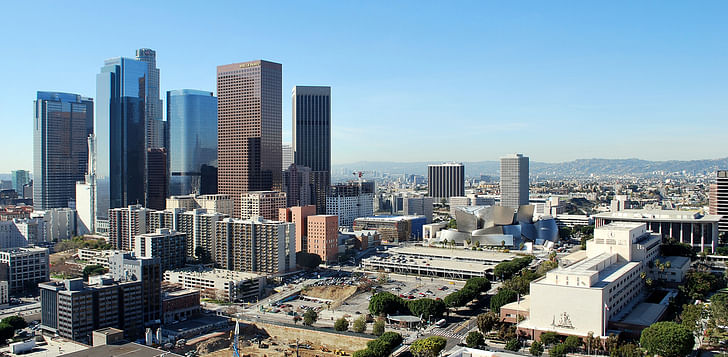
On the verge of metamorphosis, Los Angeles' Grand Avenue could do with a check-up. To take a record of the historic street, Mike "The Poet" Sonksen walks its length from Grand Park to South Park, and muses on its rich history from downtown's beginnings.
Los Angeles’ Grand Avenue is currently in the flux of massive redevelopment projects, undertaken by two of the city’s most formidable regional identity-makers, Frank Gehry and Eli Broad. Designs for Gehry’s $3 billion mixed-use Grand Avenue Project, a massive revitalization endeavor for the surrounding Downtown, seems to have finally found footing for construction to begin in 2015, and The Broad contemporary art museum will open just south of Walt Disney Concert Hall late this year. Also on Grand sits the beleaguered Museum of Contemporary Art, having recently triumphed over financial woes by solidifying a $100M endowment, alongside other cultural institutions such as Grand Park and the L.A. Music Center.
Amid a rapidly gentrifying Downtown, and L.A. establishing a more nuanced national image, Grand Ave. risks being weighed down by its own icons in order to live up to its name. But there is no doubt that the street represents an exciting shift for the entire city, and soon(ish) will be utterly transformed. Before it becomes unrecognizable (hopefully for the better), Archinect enlisted the sharp eyes and mind of Mike Sonksen, aka Mike the Poet, to document Grand Ave. in its current historical state with his piece, “Wouldn’t it be Grand to Hope to pick Flowers at Figueroa?”.
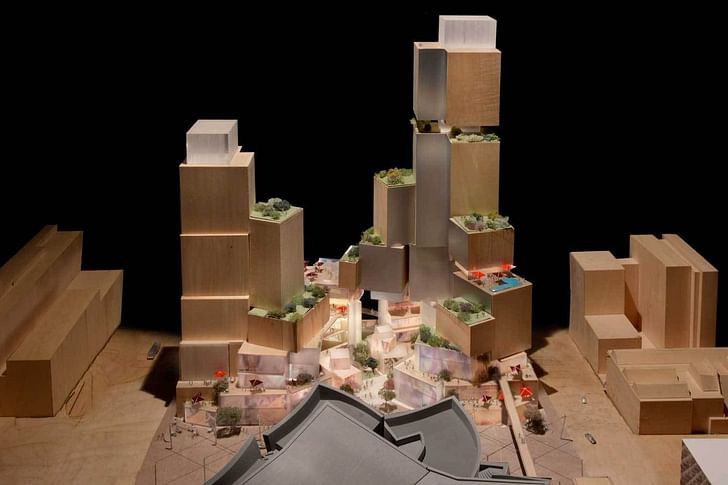

Sonksen is a prolific Los Angeles booster, shining through his city tours, poetry performances and urbanism writing. He has guided tours throughout nearly every single L.A. neighborhood since 1997, after finishing undergraduate work with Mike Davis at UCLA. We hope that his piece can be a time capsule for a section of Los Angeles, on the cusp of defining itself for the new millennium.
Grand Avenue: From South Park to Grand Park
“Wouldn’t it be Grand to Hope to pick Flowers at Figueroa?”
by Mike Sonksen
In a city of famous streets, Grand Avenue is one of Downtown’s shining stars. Grand is in the news again lately because the Walt Disney Concert Hall just celebrated its 10th anniversary and the new massive Grand Avenue project is in the final stages of approval. Much has been made about the transformation of Downtown over the last decade and there’s no denying the Disney Concert Hall has been one of the crown jewels but something most do not know is that two miles south, near Grand and 23rd, an urban transformation is taking place. Aside from the nonstop flurry of construction at nearby U.S.C., a series of new buildings at the forgotten Trade Tech College are coming to rise, beautifying the heavily used, but underappreciated local school. This essay will examine Grand’s built environment and highlight local history along the street from its beginning south of Downtown all the way to where Grand crosses the 101 freeway and ends above Chinatown. What follows is a 23-block visual narrative.
As much as Grand is known for the Disney Concert Hall, MOCA, the Colburn School, the Music Center, Grand Park and the new Broad Museum, the southern side of the street is also fascinating for lesser known sites like Trade Tech College, the Trinity Auditorium and the Olympic Auditorium. The street is one of the primary north-south spines of Downtown. Grand begins at 39th Street just east of Exposition Park, the Memorial Coliseum and U.S.C.
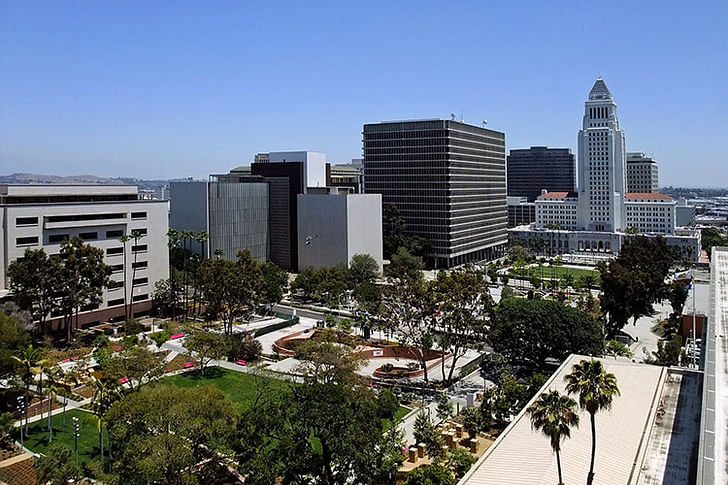
Grand packs density in a little more than four and a half miles of concrete before ending north of Avenida Cesar Chavez in the hills above Chinatown. Skyscrapers, public art, cultural institutions, lost landmarks and pocket parks form the fabric of Grand. Doug Suisman, author of the seminal work Los Angeles Boulevard: Eight X-Rays of the Body Public, writes, “Grand Avenue, which runs along the ridge of Bunker Hill, could be considered the Frankenstein monster of Downtown Los Angeles: an experimental mechanical street, constructed in the wake if the massive demolition of buildings and the destruction of natural topography of Bunker Hill.” Suisman’s assessment of Grand is accurate.

As a native Angeleno, I am happy to see Downtown L.A. beginning to celebrate itself. One of the first key history lessons students of Los Angeles learn is that Bunker Hill was once a wealthy enclave of Victorian mansions and that Grand Avenue was originally called Charity Street. When the wealthy residents in the Bunker Hill neighborhood decided they did not want their street to be associated with charity, the name was changed to Grand back in the late 19th Century. By the Depression, Bunker Hill slowly evolved into a working class area of single room occupancies, Filipino Dancehalls and walk up hotels. John Fante wrote romantic tales about these days in books like Ask the Dust and Dreams from Bunker Hill. After the entire neighborhood was razed during the late 1950s, skyscrapers slowly came to rise on Bunker Hill. Images of the old streetscape remain in some old Noir films and books by Fante and the Filipino poet Carlos Bulosan.
Two miles south on Grand, a series of new buildings are coming to rise at Trade Tech College. Long an institution in Downtown’s educational landscape, Trade Tech is on Grand from 23rd to Washington and transfers to all the local schools. Two new structures Aspen Hall and Juniper Hall on the south side of Trade Tech give the campus a contemporary ambiance and have really helped make the underappreciated school look much more modern.

Over the last few years I have been watching the construction. I decided to park my car near here and walk up Grand to examine the landscape even closer. Moreover I can also ride the train back to my car from Grand Park. Beginning at 23rd and Grand the plan is walk 23 blocks to the Music Center past Grand and First.
Trade Tech is one of several schools being upgraded in the community college system. The two new structures designed by MDA Johnson Favaro have a decorative flair with sweeping waves and a series of curves gracefully embedded in the rectangular institutional structure. The new buildings at Trade Tech are a part of a plan to transform local community colleges into green campuses. This is an honorable cause because Trade Tech serves the city well and has for generations. Located less than a mile away from U.S.C., which is one of the wealthiest private universities in the world, Trade Tech has quietly transferred hundreds of thousands of students to four-year schools over the years. I’ve known several artists and fashion designers that started their studies at Trade Tech. This section of the city is changing quickly. Just south of Trade Tech is the new “Lorenzo” complex. The sign reads, “upscale student living.” Several new upscale student condo complexes like the Lorenzo have emerged on both sides of the 110. Walking past the new buildings at Trade Tech I also noticed that there are a few more structures in the works on the east side of Grand. Closer to Washington is the older part of the campus. The future of Trade Tech is bright for multiple reasons. Besides the new buildings, the location is convenient and central next to the Metro Blue Line. And Though Washington is messy to drive, metro commuters have a smooth ride to Long Beach.
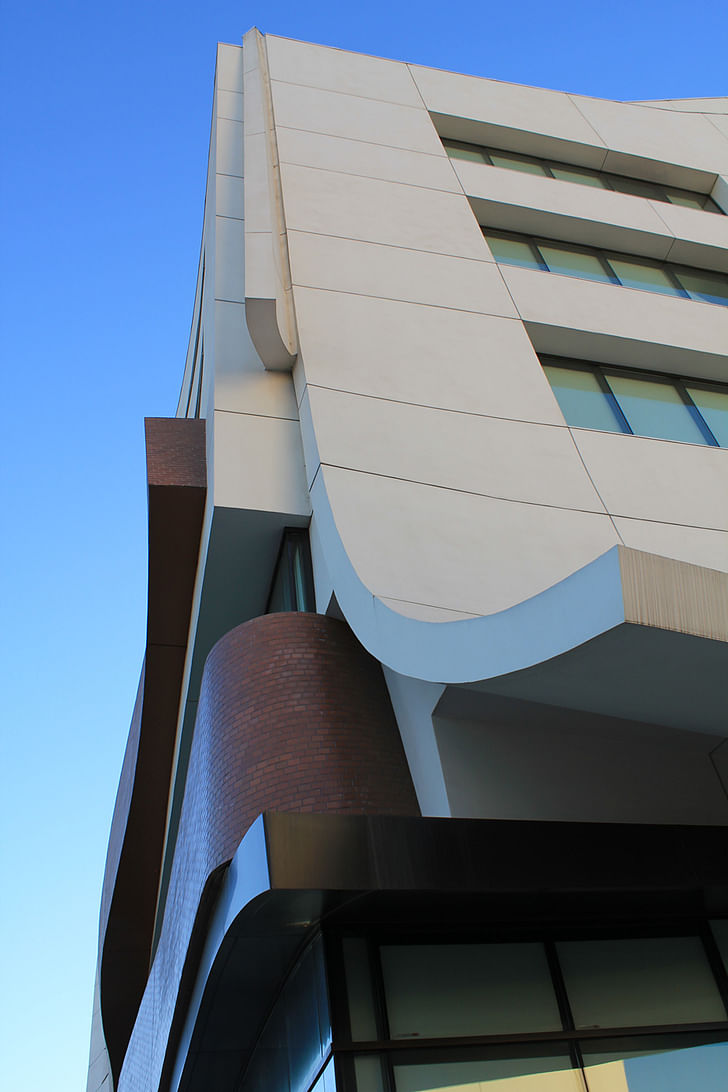
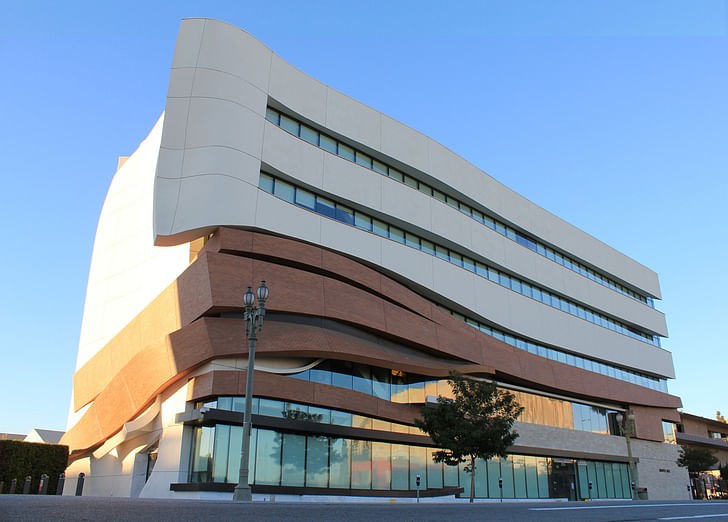
North of the train and Washington is the former Olympic Auditorium, which is now the Glory Church of Christ. Thousands of concerts, boxing and wrestling events were held in the old structure from 1924 until 2005, including the 1932 Olympics. Famed Angeleno underworld poet Charles Bukoswki often wrote about watching the fights at the Olympic Auditorium. A few scenes from the original “Rocky” were filmed there as well. Like so many old former theaters or movie palaces, it now houses a church.
Admittedly this part of Grand is less picturesque than the northern stretch. After all only a few years ago, the South Park district was mostly car dealerships, parking lots and warehouses. Following the construction of Staples Center and L.A. Live, several new housing structures have emerged in the area, both high-rise and smaller scale options. Staples Center was built quickly and opened in time for the 1999 NBA season. The Lakers responded by winning championships their first three years in the building.
Walking up towards Venice Blvd. I see well painted bike lanes, pine trees and a black bird on the power wire. “Please curb your dog” reads the small placard on the chain link fence. I see businesses like the South Park doggie day care. Near the AT&T Tower, a big sign says, “$12 for parking.” The historic architecture of Broadway comes into view including the always picturesque Eastern Columbia building in all of its terra cotta glory lurking to the northeast. Walking up on 11th Street the sleek new high rise condos of the Evo building mark the transition into the new South Park.
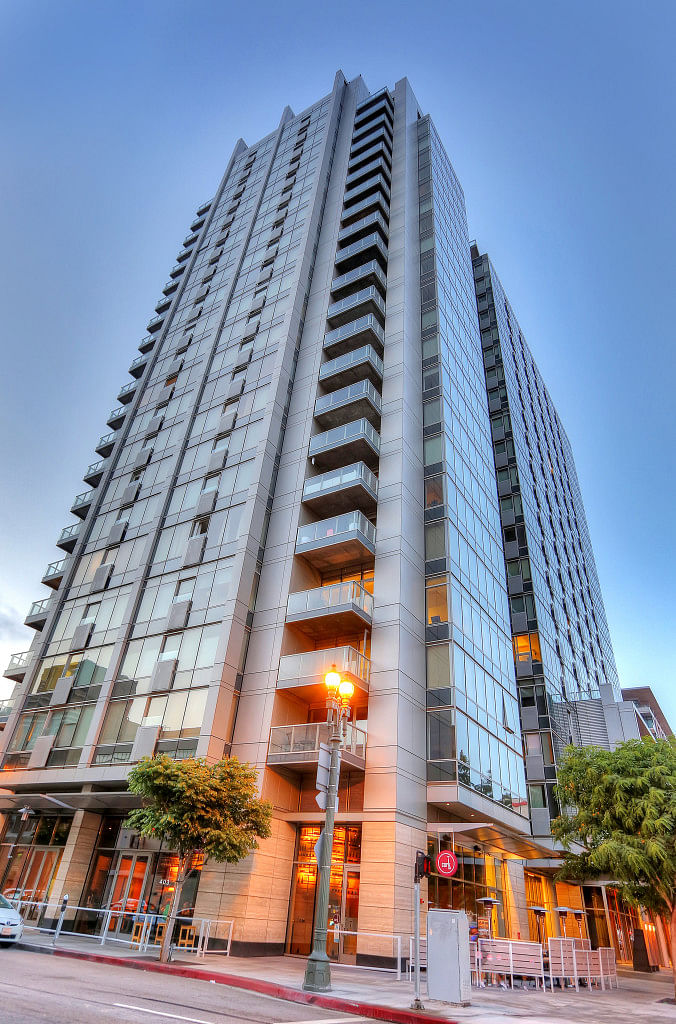
The Evo is one of the newest developments in the neighborhood, an example of an emerging style of condos called the Blade Tower. Spin about the design attributes the style’s birthplace to the Pacific Northwest. Portland’s Pearl District as well as Seattle and Vancouver have similar buildings as well. The building’s skin is a glass-curtain-window wall that maximizes natural light and is said to make the power bill significantly smaller for residents. Within a few blocks of the Evo units are some similar projects. The Starbucks on the corner is no surprise either.
Anyone interested in seeing the past, present and future of Downtown Los Angeles could learn a lot from a walk along Grand Avenue.At Olympic and Grand is FIDM (Fashion Institute of Design and Marketing) and a pocket park often filled with fashion students. Across the street behind concrete pillars is the Federal Reserve. Between 9th and 8th is the massive 1914 Beaux Arts building that once housed the Trinity Auditorium. The Los Angeles Philharmonic once played in the decadent old structure. At 8th and Grand I look to see the old concrete Bristol Hotel a few blocks east. Most of the front of the midsize skyscraper is covered with a large image of a hand throwing up a “W” sign. For all of those not around during the 1990s, the W sign signified the Westside and West Coast pride. As a native Angeleno, I am happy to see Downtown L.A. beginning to celebrate itself.
At 7th and Grand, I see hundreds of hungry folks clustered in Bottega Louie, one of Downtown’s most famous eateries. 7th was once Downtown’s primary shopping street and buildings like the nearby Los Angeles Athletic Club and Fine Arts Building reflect 7th’s importance in the Downtown infrastructure. Wilshire and Grand is where Wilshire ends. The modernist One Wilshire building marks the site where the 16-mile long boulevard begins its journey to the Pacific.
Past Wilshire I pass the Caravan bookstore, the last remaining bookstore of the old bookstore row centered around 6th and Grand. Approaching 5th is a cluster of iconic buildings like the Central Library and Biltmore Hotel. The Biltmore once hosted the Oscars and is known as the site where MGM art director Cedric Gibbons came up with the design for the Oscar statue. Schultze and Weaver, the New York architects of Waldorf Astoria fame designed the Biltmore in 1923 and it still retains the old world charm. The Biltmore is also known as the last place Elizabeth Short, the Black Dahlia murder victim, was seen alive.

The Gas Company Tower on the northeast corner of Fifth and Grand is one of the city’s most formidable skyscrapers. In the film Collateral, Jamie Foxx picked up Tom Cruise in front of the building right after Cruise comes down the escalator visible from the front. The postmodern skyscraper structure is 52 floors and the decorative wedge near the top is intended to mimic the shape of a gas flame or pilot light on a stove. Frank Stella’s large mural “Dusk” is on the AT&T building to the north.
The Edison Building directly north of the library and one building east of the U.S. Bank Building is an art deco gem that still holds up. It was used in Dudley Moore’s film Arthur. Walking up hill into the Financial District, there’s the AT&T Building. The sculpture on the façade of the building is one of my favorite pieces of public art in the city. Designed by Anthony Heinsbergen, the piece’s shuffled geography of Africa over Asia is a commentary on how technology changed communication in the 20th Century. Heinsbergen’s work is now several decades old, even predating the internet, but it’s core theme is more true now than ever before. I briefly sat on some nearby steps to admire the piece, answer my cell phone and catch my breath when a security guard with slick earphones in a black suit tells me that I cannot sit there. Bunker Hill has changed since the days of John Fante.
A few years ago, the City of Los Angeles officially designated Fifth and Grand as “John Fante Square.” Fante lived in the area for a while in Bunker Hill during the 20s and 30s, the heyday of its early decadence. Fante’s name at the corner is well deserved. I wonder what he would think of the new buildings.
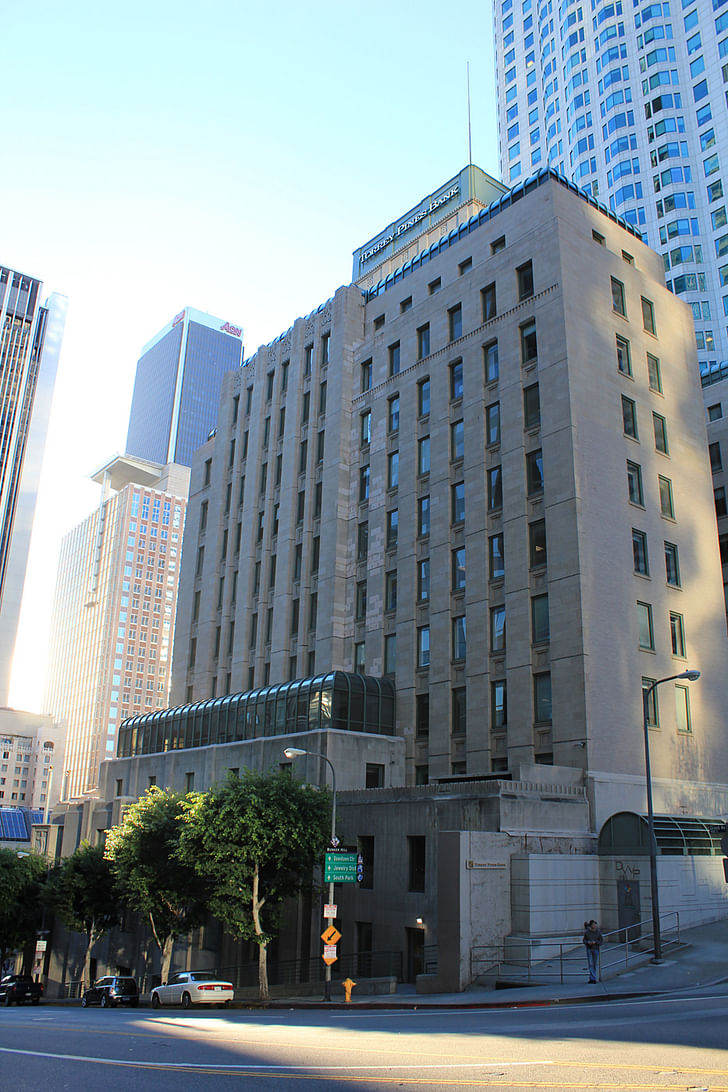
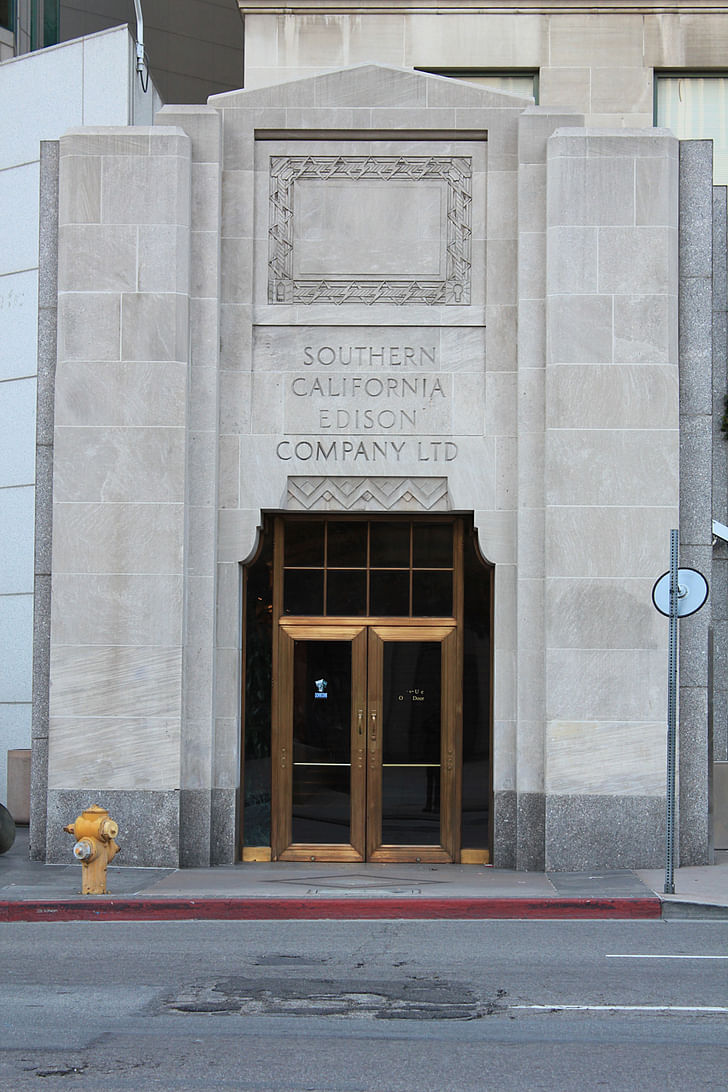
Up near the skyscrapers of the Wells Fargo Center, the Disney Concert Hall fully comes into view. There’s not much to say about the hall that has not already been said, but it is indeed every bit the icon Frank Gehry intended. City boosters have been calling Grand, “the Grand Avenue Cultural Corridor,” for a while now and the title becomes truer every year. Moreover Eli Broad’s new art museum is almost completed as well as an adjacent new high rise condo. On the eastside of Grand, across from the hall, lurks an old parking structure that is destined to be replaced by a large skyscraper and the massive Grand Ave project. The sun was setting as I arrived at Grand Park.
The geometry connecting the Dorothy Chandler Pavilion and City Hall via Grand Park makes for a scenic civic vista. On the eastern horizon, the giant light bulb on top of the structure otherwise known as the Lindberg Beacon was on and city hall -- bathed in twilight’s purple glow -- looked like the monument that it is. I thought about the “City Beautiful” movement and how the long vista of Grand Park frames City Hall and emphasizes the majesty of its iconic architecture. As much as planners talk about ideas like “choreographed urban passageways,” and other Utopian ideas, the organic unity connecting the Music Center, Grand Park and City Hall does indeed inspire civic pride. Grand Park is working. North of the park include the Cathedral and new massive high school on the other side of the freeway before Grand ends in the hills north of Sunset just shy of Dodger Stadium.

After a satisfying 23 block walk, it was time to go home. Boarding Metro from the Civic Center station, I transferred onto the Blue Line at 7th and Figueroa. As I was filing my way out of the packed train, I saw surrealist poet Will Alexander run down the escalator and narrowly slip into the train I just exited. Seeing Alexander in the train station punctuated a surreal afternoon walk in the city. Alexander is published by City Lights and just won the American Book Award. Though I didn’t have a chance to say hello because we were both moving so fast, it seemed to be a powerful omen about the afternoon’s journey. Alexander writes about making cosmic leaps and the daily magic one finds when they become aware of inner electricity. It was rather surreal to see Alexander barely catch the full, departing train. I rode a few exits to my car near Trade Tech.
Grand Avenue is a work in progress; the cultural corridor near its northern end continues to evolve. Grand Park anchors iconic architecture and the former streetscape continues to be replaced with museums and high rise condos. On the south side of Grand, the slow and steady development near Trade Tech offers its own brand of promise and urban optimism. The development along the dense street will continue to even out. Obviously much more is in the works but anyone interested in seeing the past, present and future of Downtown Los Angeles could learn a lot from a walk along Grand Avenue.
- Mike "The Poet" Sonksen, @mikethepoetLA
Former Managing Editor and Podcast Co-Producer for Archinect. I write, go to the movies, walk around and listen to the radio. My interests revolve around cognitive urban theory, psycholinguistics and food.Currently freelancing. Be in touch through longhyphen@gmail.com
2 Comments
As much as I like poetry I m dont read any poetry in this.Maybe because there are no poetic devices like metaphors or simile. Maybe because there isn't any 'poetic' mood or poetic structure in the form of presentation. I dont even sense a point of view, really.
This is more descriptive prose lacking figures of speech. I dont see much difference between this and straight descriptive reportage.
I've read a lot of poetry. I have a few hundred volumes on my shelf. I think I can recognize poetry and poets. This it is not .
I once ran into someone who said he was a photographer. We chatted and he showed his photos. Nothing to look at. I went off and mumbled "this guy isn't a photographer. He's just a guy holding a camera"
I got the same feeling about Mike the "poet' . Just someone with a keyboard.
eric chavkin
I agree with Eric, re. the lack of overt poetry. But I don't wish to discourage even the idea of poetry as having some connection to architecture. Please keep it up; the world is blind and need word-eyes.
Block this user
Are you sure you want to block this user and hide all related comments throughout the site?
Archinect
This is your first comment on Archinect. Your comment will be visible once approved.